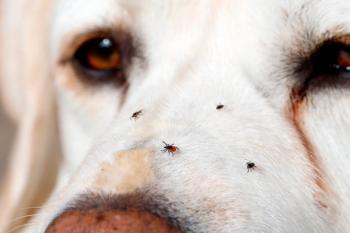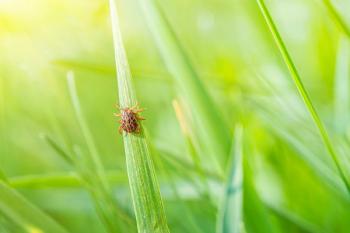
Zoonotic diseases (Proceedings)
Bacillus anthracis.
Anthrax
- Bacillus anthracis
- Ruminant reservoir
- Human:
- Reportable disease
Animals
- Sudden death
- Bloody discharge from orifices that DOES NOT CLOT
- Do not necropsy; burn carcass, send ear only to lab for confirmation of disease
Human
- 95% cutaneous
- Small, painless, red pruritic papules on skin that ulcerate; Tx w/ AB's
- Inhalation à FATAL URI with fever, shock and respiratory distress; death in 24h
Avian chlamydiosis
- “Ornithosis/Psittacosis”
- Chlamydophila psittaci
- Bird reservoir
- Humans have flu like symptoms
- Fever, chills, headache, muscle aches, URI & LRI symptoms
- Reportable disease
- Birds are often subclinical
- Yellow-green diarrhea, conjunctivitis, nasal discharge, respiratory difficulty
- Bacteria can persist in dander/heating/air ducts
- Responds to antibiotics
Avian and swine influenza
- Normally not infective to humans
- Mutations/variations can occur that can lead to efficient transmission and binding to human cell receptors
- Wear PPE when dealing with avian and swine that are suffering from respiratory disease
Brucellosis
- Brucella abortus, B. melitensis, B. suis, B. canis
- Ruminants, horses, swine, dogs
- Human
- Reportable disease
Animal-to-animal or –to-human transmission
- Ingestion of materials contaminated with infected birth fluids.
- Coitus (pigs & dogs)
- HUMAN: Farmers moving placentas, etc. OR… Inoculation with the Strain 19 vaccine…OR…Consumption of infected milk, or cleaning or eating infected feral swine
Animals
- Abortion
- Orchitis,
- Infertility
Cat scratch fever
- Bartonella henselae
- Cats
- Cats have bacteria, asymptomatic
- Fleas ingest, shed in flea feces
- Human
- Flea feces contaminate human wound
- Lymphadenopathy
- Self-limiting disease (2-3wks) or chronic malaise that can mimic Lyme disease
Humans: Infection worse in immunocompromised people
- Local skin rxn & enlarged l.n. in area of bite
- 1/3 of people will have fever, headache & malaise
PREVENTION = Flea control!
Problem in nursing homes if animals are not well cared for
Gastointestinal disease
- Campylobacter jejuni & C. coli
- Birds & mammals (Chickens, cattle, pets)
- Cryptosporidium sp.
- Mammals, esp. cattle
- Enteric Bacteria
- Salmonella, E. coli
- Wash hands! Keep things out of mouth!
- Most self- limiting diarrhea in humans if immunocompetent
- Food ingestion is common means of infection; direct contact possible
Leptospirosis
- Leptospirosis is a zoonotic disease with a worldwide distribution and can potentially infect all mammals.
- Leptospirosis is an aerobic, gram negative spirochete bacterial infection caused by members of the genus Leptospira, which contain around 220 distinct pathogenic serovars.
- Common maintenance hosts of certain pathogenic Leptospiral serovars:
- Dogs – Canicola
- Pigs, cattle, oppossums, and skunks – Pomona
- Raccoons and muskrats – Grippotyphosa
- Cattle – Hardjo
- Rats – Icterohaemorrhagiae
- Pigs and possibly mice and horses – Bratislava
- Leptospirosis is typically transmitted by direct contact with the urine or other body fluids of infected animals or indirectly through contact with water or soil that has been contaminated with infected urine/body fluids.
- An array of clinical effects have been reported, ranging from mild, subclinical infection to multiple organ failure and death.
- Clinical signs of leptospirosis in wildlife have not been thoroughly documented, but it is believed that most infected wildlife are asymptomatic and serve as maintenance hosts for transmission of the organism to domestic animals and humans.
- Clinical signs of leptospirosis in domestic animals and humans is species dependent but generally includes alterations in liver and kidney function. Infections in these incidental hosts can be asymptomatic or may result in kidney and/or liver failure, fever, jaundice, and death
Plague
- Yersinia pestis
- Two forms Bubonic and pneumonic
- Bubonic
- Rodents, lagomorphs
- Spread through flea bites
- Pneumonic
- Cats, man
- Spread through aerosol
- Dogs are resistant but can carry the fleas
- Reportable disease in US
- Tx systemic abs
Clinical signs in cats
Clinical signs vary depending on what form of plague is present. Plague should be suspected in any cat exhibiting a fever in an endemic region. Cats with bubonic plague typically have fever, dehydration, lethargy, weight loss, hyperesthesia, and lymphadenopathy. The submandibular, cervical, and retropharyngeal lymph nodes are usually involved if the cat acquires infection by ingestion of infected prey. Lymph nodes will enlarge, form abscesses, and may spontaneously drain.
Toxoplasmosis
Domestic and wild felids are the definitive host for the protozoan Toxoplasma gondii. The oocysts of Toxoplasma are extremely environmentally resistant and human and animal infections can occur months or possibly even years after the cat has excreted the oocysts. As such, cat feces-contaminated gardens, sandboxes, and other outdoor recreational areas may serve as a source of infection for humans and animals. In toxoplasmosis, infection occurs primarily by ingestion of sporulated oocyst in cat feces- contaminated soil or water or tissue cysts in undercooked or raw meat. Upon ingestion of tissue or environmental cysts, the parasites are released, penetrate the intestinal bilayer, and replicate rapidly inside host cells. Currently, toxoplasmosis is considered the third most frequently diagnosed food borne disease in the US and approximately 60 million US citizens are infected with the parasite. Higher frequency of T. gondii seroprevalence has been disclosed in free-roaming cats compared to pet cats, with the lowest seroprevalence in cats kept indoors.
Although the risk of infection of human infection through ingestion of oocysts has been less common than infection from ingestion of undercooked or raw meat, recent research suggests otherwise. A recently developed sporozoite specific antibody has been developed which allows for serological distinction between oocyst and tissue cyst infection given that sporozoites are only present in oocysts. Of 163 individuals in acute stage of toxoplasmosis infection 103 (63%) were positive for sporozoite-specific antibody indicating that the majority of human infection was due to oocyst infection from cat-feces contaminated environments. Clinically, Toxoplasma infections appear as abortions, and birth defects, as ocular diseases, neurological impairment leading to blindness, particularly hydrocephalus, in humans. Furthermore, toxoplasmosis is also a significant risk in individuals undergoing immuosuppressive therapy including transplant recipients. Toxoplasmosis is also a major cause of systemic infection and death for immunosuppressed (e.g., HIV/AIDS) patients. An increased of risk of neuro-inflammatory diseases including schizophrenia, autism, Alzheimers, and other has been suggested with T. gondii; more research is warranted to elucidate the neurological impacts of T. gondii.
Tick-borne diseases
Tick paralysis
Potentially fatal reaction to a paralyzing neuromuscular toxin secreted in the saliva of a female tick late in her feeding. Cattle, sheep, horses, dogs, and humans seem to be most effected.
Clinical signs include: headache, vomiting, general malaise, loss of motor function and reflexes, followed by paralysis that starts in the lower body and spreads to the rest of the body
Respiratory failure and death can result. Signs disappear rapidly when tick is removed, suggesting that the toxin is rapidly excreted or destroyed
Lyme borreliosis
- Agent: Borrelia burgdorferi
- Vector: Ixodes scapularis (Eastern and Midwestern US), Ixodes pacificus (Western US)
- Geographical distribution: New England and mid-Atlantic states, upper Mid-west, and Pacific coast.
- Animal health: Major cause of canine and equine disease, including endocarditis and joint pain. Most cases occur in the spring and summer, during nymphal emergence, and in late fall and winter, during adult emergence.
- Human health: Acute and chronic diseases including joint pain, heart disease, and neurological disorders. Most cases occur in the spring and summer, during nymphal emergence, and in late fall and winter, during adult emergence.
- Diagnoses: Lyme disease is diagnosed using serology tests, bacterial cultures, and/or PCR of tissue (NOT BLOOD). Blood may be used for PCR in very acute cases, otherwise tissue biopsy is needed. Predictive value influences serological test interpretations-only treat animals with clinical signs suggestive of disease!!!
Rocky mountain spotted fever
- Agent: Rickettsia rickettsia
- Sometimes placed in “Spotted Fever” disease group
- Vector: Dermacentor variabilis
- Geographical distribution: Eastern US mainly. Most frequently reported tick borne disease in the eastern US. Animal health: Recent evidence has shown that untreated RMSF may lead to death of the affected animal. Clinical signs include whole body pain and are painful on palpation. May see petechial and ecchymotic hemorrhages
Rabies
Although rabies is detected most frequently in various wildlife populations in the U.S., multiple recent studies have disclosed that human exposure to rabies is primarily associated with domestic cats due to people being more likely to come in contact with cats. Rabies virus is transmitted via saliva from one host to another primarily via a bite from a rabid animal. Following a bite of a rabid animal and virus inoculation, the virus replicates in neurons and disseminates via the nervous system. Later in the infection the virus can be found in highly innervated organs including cornea, skin, and salivary glands Rabies leads to various neurological impairment symptoms and the disease is invariably fatal. 92% of actual human rabies infection has been associated with bat-associated rabies virus mainly due to bat bites not being noticed by humans. Only 1% of healthy bats and 11% of sick bats are found to be rabid. Effort should be made to make houses and areas unattractive to raccoons, skunks, and other rabies hosts.
Visceral larval migrans
Baylisascaris procyonis is a roundworm of raccoons and birds are infected by ingesting larvated eggs in the environment. Dogs, kinkajous, ringtailed coatis can also serve as the definite host for B. procyonis and can shed eggs. The distribution of B. procyonis has been increasing recently. Larval migrans of B. procyonis can result in numerous neurological impairment clinical signs including encephalitis, circling, seizures, and death. Necropsy diagnostics include histopath examination and PCR. Limiting raccoon access to yard and making the areas unattractive to raccoons is the main way to prevent this disease.
Newsletter
From exam room tips to practice management insights, get trusted veterinary news delivered straight to your inbox—subscribe to dvm360.






